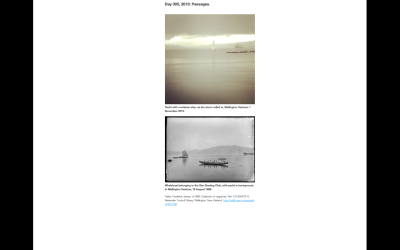Notes from a talk I gave on 7 December 2013 at an Old Hall Gig. I was chuffed (and terrified) to be invited to do this – it was a nice way to mark the impending end of the project.
Every day, for the past 340 days, I have been taking a photograph on my cell phone and matching it up with an image from the past. The project is called Tūhonohono, which means to weave together or join.
When Thomasin Sleigh first approached me to share this #threesixfive project with you, she said she was imagining my talk would be a bit like an old slide show.
I was immediately taken back to my childhood, where my father would give regular slide evenings for my brother and my mother and me, using a portable slide projector that he kept for work.
 I have very fond memories of these evenings, which introduced me not just to the power of the visual record, but also to our family history and heritage. Here’s your mother and me in Paris before you were born…. That’s you when you were learning to walk.
I have very fond memories of these evenings, which introduced me not just to the power of the visual record, but also to our family history and heritage. Here’s your mother and me in Paris before you were born…. That’s you when you were learning to walk.
Just as we would be settling in for this journey through our Kodak-coloured past, an image of something alarming, such as a hideously swollen gouty toe, would suddenly appear on the wall in front of us.
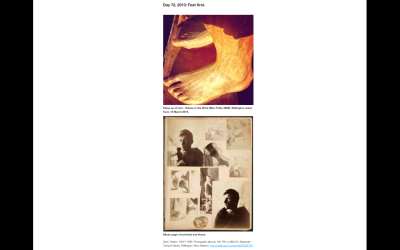 My father, who is a doctor in South Auckland, would mix together the slides he used to teach students about disease by day… with the slides of your mother and me in Paris before you were born. I assume this was accidental. But it made for an interesting juxtaposition.
My father, who is a doctor in South Auckland, would mix together the slides he used to teach students about disease by day… with the slides of your mother and me in Paris before you were born. I assume this was accidental. But it made for an interesting juxtaposition.
Despite this, or perhaps because of it, much of my professional career has been spent in service of the desire to look at – and tell stories from – images of the past.
Many of the images I’ve drawn from in this project, for example, come from digitised collections that I catalogued and made available online in one of my first ‘proper jobs’, at the Alexander Turnbull Library, which is part of the National Library here in Wellington.
I no longer work at the National Library, but I think a lot of this project has been about returning to that simple pleasure of close looking.
The connections I’ve been making between these images from the past and a cell phone photograph from my day are sometimes literal comparisons between now and then.
 These matches make me feel like I’ve been passing through a strange time-lapse sequence, set to capture images over centuries rather than hours. They’re also the kinds of connections that are reasonably easy to find when you search for heritage images online.
These matches make me feel like I’ve been passing through a strange time-lapse sequence, set to capture images over centuries rather than hours. They’re also the kinds of connections that are reasonably easy to find when you search for heritage images online.
Other connections are based around a common subject.

 Sometimes these subjects continue over time to catch my eye. For example, I’ve been taken this year by the work of a street artist doing wheat paste-ups of pigeons. You’ve probably seen them around town.
Sometimes these subjects continue over time to catch my eye. For example, I’ve been taken this year by the work of a street artist doing wheat paste-ups of pigeons. You’ve probably seen them around town.

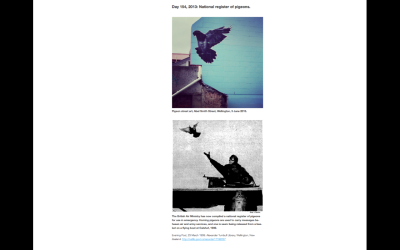

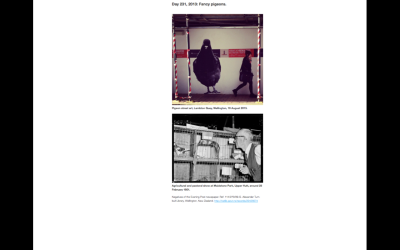 These, along with scenes from Wellington harbour, where I often find myself, are my stock photographic subjects. The pigeoner and I walk a similar beat.
These, along with scenes from Wellington harbour, where I often find myself, are my stock photographic subjects. The pigeoner and I walk a similar beat.
When I’ve had more time and wits about me, the connections are more associative. A kind of pattern recognition across multiple levels.


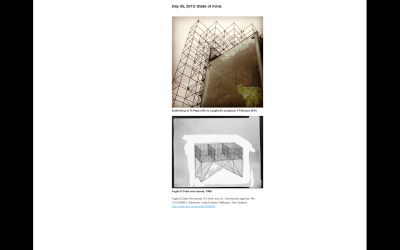 These are the ones I’ve had the most fun making, and I suspect that my small (but generous) audience on Twitter has most enjoyed seeing them too. Who doesn’t like a good visual pun?
These are the ones I’ve had the most fun making, and I suspect that my small (but generous) audience on Twitter has most enjoyed seeing them too. Who doesn’t like a good visual pun?
For me, these start to hint at intangible narrative connections, and maybe even storytelling, albeit of a slightly more whimsical sort.
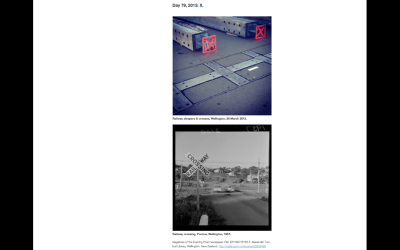 These sorts of connections are harder to find in collection databases because they’re harder to automate. They span more than space and time and subject, and start to make you feel as if somehow everything might connect.
These sorts of connections are harder to find in collection databases because they’re harder to automate. They span more than space and time and subject, and start to make you feel as if somehow everything might connect.

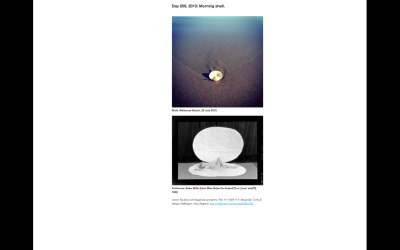
 I’m going to go on now to talk a little bit about the broader context for this project, which I’m mainly going to do by weaving together a variety of borrowed quotes.
I’m going to go on now to talk a little bit about the broader context for this project, which I’m mainly going to do by weaving together a variety of borrowed quotes.
Charles Landry, one of my favourite writers on the role of cultural institutions like libraries and museums (among other topics) writes that: “heritage works best when we perceive ourselves to be part of its continual creation”.
I carry this quote through a lot of the work that I do. If the Alexander Turnbull Library, for example, hadn’t set those heritage images free to be used on personal blogs and websites, albeit with some constraints, we wouldn’t be able to create things like this. As Landry goes on to say, “when heritage and its interpretation is allowed to ossify the past and the present begin to disconnect.”
 Nowadays of course the Web is our universal instantaneous slideshow. It’s a slideshow that moves far faster than the ones cultural institutions like the Turnbull Library can make.
Nowadays of course the Web is our universal instantaneous slideshow. It’s a slideshow that moves far faster than the ones cultural institutions like the Turnbull Library can make.
 Earlier this year, Courtney Johnston, an old colleague and friend of mine from the National Library – and now at the Dowse – gave a wonderful talk around this topic at City Gallery.
Earlier this year, Courtney Johnston, an old colleague and friend of mine from the National Library – and now at the Dowse – gave a wonderful talk around this topic at City Gallery.
Looking at social photography applications like Instagram, which is the application I use to ‘process’ the photo I take each day, she said:
“Exactly as we fix our attention on the present moment, we are recording it and assigning it to the past. Social media – and the social sharing of photographs, especially these tricked-out insta-retro images – now makes us see the present as a potential documented past. We move through the world like butterfly catchers of experiences and events, plucking them from the air and pinning them down, admiring them in flight only insofar as we’re trying to get the light right.”
I thought about this a lot in the days after hearing Courtney’s talk. Was I just a glorified butterfly catcher?
 Then I concluded that I wasn’t just seeing the present as a potential documented past, I was also seeing the past as a potential documented present.
Then I concluded that I wasn’t just seeing the present as a potential documented past, I was also seeing the past as a potential documented present.
The lag between taking a photograph during my day, and processing it at night lent this project a focus on mindfulness rather than mindlessness. Through this project I have made a deliberate and absorbing attempt to pay attention to the world – every day, for 340 days now.
I’ve had to take notice.
 Courtney knows how this works I think. I lent her the project for a week in April this year and a few days after she handed it back she said: “Everywhere I go at the moment I see great #threesixfive images. It’s killing me.” This is one of hers:
Courtney knows how this works I think. I lent her the project for a week in April this year and a few days after she handed it back she said: “Everywhere I go at the moment I see great #threesixfive images. It’s killing me.” This is one of hers:
 When I look at each image I have taken in the past year, which to be honest I haven’t really done until this past week, I can remember exactly where I was when I took it. Typically I was alone, and mostly I was walking somewhere.
When I look at each image I have taken in the past year, which to be honest I haven’t really done until this past week, I can remember exactly where I was when I took it. Typically I was alone, and mostly I was walking somewhere.
 If I wanted to increase the chance of something new catching my eye, I’d take a different side street.
If I wanted to increase the chance of something new catching my eye, I’d take a different side street.
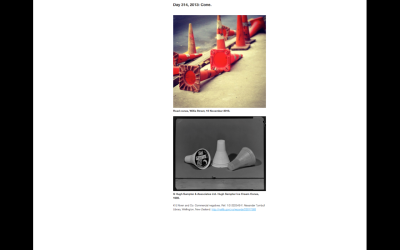 Rebecca Solnit captures the ideal condition for a project like this in her book A Field Guide to Getting Lost. She writes:
Rebecca Solnit captures the ideal condition for a project like this in her book A Field Guide to Getting Lost. She writes:
“I love going out of my way, beyond what I know, and finding my way back a few extra miles, by another trail, with a compass that argues with the map…nights alone in motels in remote western towns where I know no one and no one I know knows where I am, nights with strange paintings and floral spreads and cable television that furnish a reprieve from my own biography, when in Benjamin’s terms, I have lost myself though I know where I am. Moments when I say to myself – as feet – or car – clear a crest – or round a bend — I have never seen this place before. Times when some architectural detail on a vista that has escaped me these many years – – says to me – – that I never did know where I was – – even when I was home.”
I wish heritage collection databases were better at helping you to get lost.
 There’s something else I’ve noticed happening in this project. In all of these pairings, my somewhat amateur cell phone photography has benefited hugely from a “1 + 1 = 4” effect that you get when you place two unlikely things together to form a new whole.
There’s something else I’ve noticed happening in this project. In all of these pairings, my somewhat amateur cell phone photography has benefited hugely from a “1 + 1 = 4” effect that you get when you place two unlikely things together to form a new whole.
 Pro tip: if you want to make an average cell phone image resonate, put an archival image from the past beside it.
Pro tip: if you want to make an average cell phone image resonate, put an archival image from the past beside it.
 In that same talk I referenced earlier, Courtney Johnston went on to say:
In that same talk I referenced earlier, Courtney Johnston went on to say:
“Some commentators argue that the rise of the faux-vintage photo points to an attempt to harness the power of the past – the emotional punch of nostalgia – to make our photos, and by extension, the moments of our lives they record – more important, more substantial, more real.”
And you know what? I’m down with that. I have no issue whatsoever with my life feeling more substantial, especially after years of working on the web. In fact I’m probably even tending towards a hyper-real where the past and the present are, if not indistinguishable, inextricably connected.
 Taking these images from my day and pairing them up with one from the past at night has become a discipline it’s going to be hard to let go of.
Taking these images from my day and pairing them up with one from the past at night has become a discipline it’s going to be hard to let go of.
 Another friend of mine, Mike Kmiec, did a similar project in 2012 but just took a photo each day. When he finished, he reflected:
Another friend of mine, Mike Kmiec, did a similar project in 2012 but just took a photo each day. When he finished, he reflected:
“If this project has taught me anything, it’s to look at the world around me with a bit more depth. I’ve found myself reaching for the camera whenever there’s something funny, or beautiful, or striking, and that pause has been good. I hope that lesson continues to be learned.”
Which leaves us with the future. All of the photographs I’ve taken this year are available openly on the web for people to use freely as they wish.
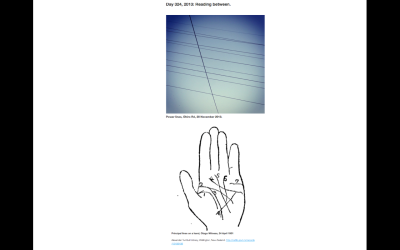 To my delight, just last week, another employee of the National Library, Chris McDowall took them all and turned them into something that makes me feel present and nostalgic and optimistic about the future all at the same time. This is a screen shot from his project.
To my delight, just last week, another employee of the National Library, Chris McDowall took them all and turned them into something that makes me feel present and nostalgic and optimistic about the future all at the same time. This is a screen shot from his project.
 Chris writes:
Chris writes:
“With metadata and colours in hand, I started playing with the photographs. I was unsure what I was making except that I wanted to see all of the colours in Virginia’s year at once, and a sense of dynamism. I wanted the screen to pulse and change and fade and glow. The colours of Tūhonohono is a small attempt to share what has been like to follow this photography project over the course of the year. I wanted to provide a space for people to make their own connections from Virginia’s photographs. It is a thing built out of impressions, glimpses and intuition.”
I love that he did this, including because it is a nod towards the continual creation of which Charles Landry speaks.
And I think on that note, knowing that slideshows always seem to go on just that little bit too long, I’m going to bring this one to an end.
Thank you so much to all who followed this project over the past 365 days. You’re wonderful. A lot of the thinking in this talk also stems directly from my time with the Cooper-Hewitt Labs team in New York City, who are pushing the boundaries of collections online.
